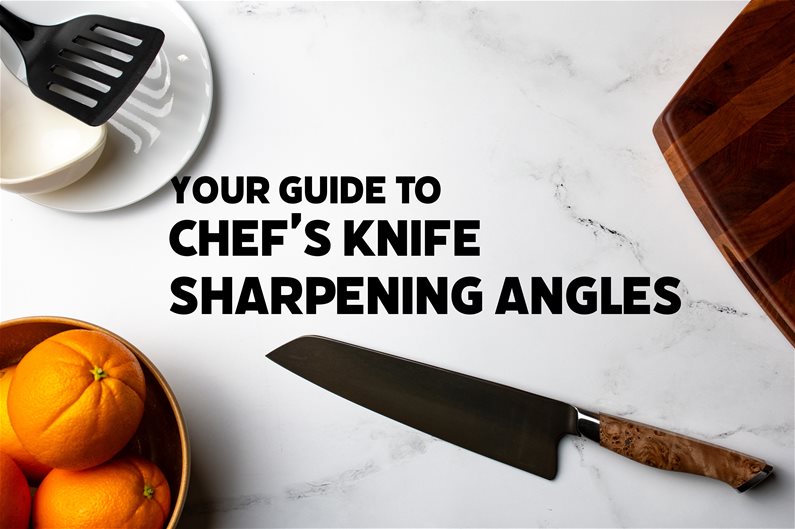What Angle Should I Sharpen My Chef’s Knife?

Knife Skills 101: Choosing the Right Sharpening Angle for Your Chef's Knife

Every home chef understands the value of a sharp and well-maintained chef's knife. It's the true hero of the kitchen, capable of transforming ordinary meals into culinary masterpieces. However, your chef's knife will need a bit of upkeep. Choosing the right sharpening angle is the secret ingredient that can elevate your knife skills to a whole new level. In this comprehensive guide, we'll explore the theory behind selecting the perfect sharpening angle and provide you with practical advice to enhance your culinary experience.
The 20-Degree Sharpening Angle: A Solid Starting Point
A 20-degree sharpening angle is your go-to starting point when it comes to sharpening most chef's knives. This angle strikes a balance between sharpness and durability, making it an excellent choice for a wide range of kitchen tasks.

Sharpening at 20 degrees is a great starting point for most kitchen knives.
Navigating the Sharpness vs. Durability Dilemma
Choosing the right sharpening angle isn't just about making your knife sharp; it's also about preserving its edge for the long run. It's a delicate dance between sharpness and durability. Lower angles (below 20 degrees) provide extraordinary sharpness, making slicing effortless. However, they come with a trade-off—lower durability and a higher risk of the edge chipping or folding over. Conversely, higher angles offer increased durability, making your knife edge resilient to impacts. But be prepared for slicing tasks that require a bit more effort.
When to Embrace a Lower Angle
Lower angles typically range from 10 to 17 degrees, with 15 degrees being a popular choice for many kitchen knives. Here are scenarios where opting for a lower angle makes perfect sense:
- Enhanced Cutting Performance: Lower angles excel in precision tasks that demand finesse. Slicing ripe tomatoes or expertly carving delicate pieces of fish becomes effortless with a lower-angle edge.
- Softer Materials: When your ingredients are gentle on the blade, lower angles shine. Think of effortlessly slicing through mushrooms, tender fruits, or leafy greens.
- Slicing Cuts: If you’re primarily pulling a slicing cut with your chef’s knife, then the edge will benefit from a lower angle. There isn’t much stress being placed on the edge and the lower angle helps the knife glide through the cut.
- Harder Steel: Knives with harder steel, commonly found in East Asian-style chef’s knives, can benefit from lower angles. The increased hardness reduces the risk of deformation but requires proper care to prevent chipping.

When to Embrace a Higher Angle
Higher angles are those above 20 degrees, maxing out around 25 degrees. Consider the following situations where sharpening at a higher angle is the smarter choice:
- Durability Demands: If your culinary adventures involve tackling tough jobs like cutting through bone-in meat, a higher angle will fortify your knife's edge against wear and tear.
- Chopping: Hard-use chopping, especially when the knife is impacting forcefully into the cutting board can be tough on a delicate edge. Putting a higher angle will give your edge the strength it needs to keep on cutting.
- Softer Steel: Higher angles are ideal for preventing the edge of your Western-style stainless-steel knife from folding over during heavy use. This ensures long-lasting sharpness.
Customizing Your Angle: The Personal Touch
While a 20-degree angle is a fantastic starting point, remember that your choice of sharpening angle is a personal preference. Feel free to customize it to align with your unique cooking style. Experiment by slightly raising or lowering the angle until you discover the perfect fit for your needs. If you were happy with your knife’s performance before it needed sharpening, matching the existing angle is also a great option.
Finding Your Angle: A Practical Approach
For those sharpening by hand on whetstones, finding a 20-degree angle is relatively straightforward. Here's a practical method:
- Start with the knife perpendicular to the stone. This is 90 degrees.
- Lower the back of the blade halfway down to the stone. This is 45 degrees.
- Lower it halfway again. This is 22.5 degrees.
- Lower a little bit more, aiming for that 20-degree sharpening angle.
While achieving an exact angle is ideal, maintaining a consistent angle throughout the sharpening process is even more crucial. Strive for consistency; sharpening consistently at 22 degrees is more effective than wavering between 19 and 21 degrees.
Helpful Accessories
An angle guide set can provide a reference for your chosen sharpening angle. A useful tool to get a sense of what different sharpening angles feel like.
This magnetic Angle Cube will attach to the side of your knife and display the angle you’re holding it. Another useful tool to help you understand what sharpening at different angles feels like.
Guided Sharpeners: A Shortcut to Precision
If the idea of hand-sharpening on whetstones doesn't appeal to you, there's a world of guided sharpeners waiting to make your life easier. These manual guided sharpeners allow you to sharpen with pinpoint accuracy, without relying solely on your sharpening skills. For those craving speed and efficiency, electric sharpeners are also an option. They come with pre-set angles and motor-driven abrasives that can quickly restore your knives to their former glory.
Conclusion
In the kitchen, your chef's knife is your trusted companion, and mastering its edge is an essential skill. By understanding the theory behind selecting the correct sharpening angle, you can ensure that your knife is always ready to slice, dice, and chop with precision.



